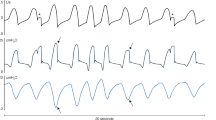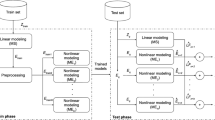Abstract
Several key areas in modeling the cardiovascular and respiratory control systems are reviewed and examples are given which reflect the research state of the art in these areas. Attention is given to the interrelated issues of data collection, experimental design, and model application including model development and analysis. Examples are given of current clinical problems which can be examined via modeling, and important issues related to model adaptation to the clinical setting.
Similar content being viewed by others
References
Aittokallio J, Polo O, Hiissa J, Virkki A, Toikka J, Raitakari O, Saaresranta T, Aittokallio T (2008) Overnight variability in transcutaneous carbon dioxide predicts vascular impairment in women. Exp Physiol 93:880–891
Aittokallio T, Gyllenberg M, Polo O, Toivonen J, Virkki A (2006) Model-based analysis of mechanisms responsible for sleep-induced carbon dioxide differences. Bull Math Biol 68:315–341
Aittokallio T, Gyllenberg M, Polo O, Virkki A (2007) Parameter estimation of a respiratory control model from noninvasive carbon dioxide measurements during sleep. Math Med Biol 24:225–249
Aittokallio T, Virkki A, Polo O (2009) Understanding sleep-disordered breathing through mathematical modeling. Sleep Med Rev 13:333–343
Batzel JJ, Baselli G, Mukkamala R, Chon KH (2009) Modelling and disentangling physiological mechanisms: linear and nonlinear identification techniques for analysis of cardiovascular regulation. Philos Transact A Math Phys Eng Sci 367:1377–1391
Bellman R, Åström KJ (1970) On structural identifiability. Math Biosci 7:329–339
Burth M, Verghese GC, Vélez-Reyes M (1999) Subset selection for improved parameter estimation in on-line identification of a synchronous generator. IEEE Trans Power Syst 14:218–225
Cavalcanti S, Cavani S, Ciandrini A, Avanzolini G (2006) Mathematical modeling of arterial pressure response to hemodialysis-induced hypovolemia. Comput Biol Med 36:128–144
Chaicharn J, Carrington M, Trinder J, Khoo MCK (2008) The effects on cardiovascular autonomic control of repetitive arousal from sleep. Sleep 31:93–103
Chapman MJ, Godfrey KR, Chappell MJ, Evans ND (2003) Structural identifiability for a class of non-linear compartmental systems using linear/non-linear splitting and symbolic computation. Math Biosci 183:1–14
Cheung SY, Evans ND, Chappell MJ, Godfrey KR, Smith PJ, Errington RJ (2008) Exploration of the intercellular heterogeneity of topotecan uptake into human breast cancer cells through compartmental modelling. Math Biosci 213:119–134
Cobelli C., DiStefano 3rd JJ (1980) Parameter and structural identifiability concepts and ambiguities: a critical review and analysis. Am J Physiol 239:R7–24
Evans ND, Chappell MJ (2000) Extensions to a procedure for generating locally identifiable reparameterisations of unidentifiable systems. Math Biosci 168:137–159
Fink M, Batzel JJ, Tran HT (2008) A respiratory system model: parameter estimation and sensitivity analysis. Cardiovasc Eng, Int J 8:120–134
Foster GE, Hanly PJ, Ostrowski M, Poulin MJ (2007) Effects of continuous positive airway pressure on cerebral vascular response to hypoxia in patients with obstructive sleep apnea. Am J Respir Crit Care Med 175:720–725
Foster GE, Hanly PJ, Ostrowski M, Poulin MJ (2009) Ventilatory and cerebrovascular responses to hypercapnia in patients with obstructive sleep apnoea: effect of CPAP therapy. Respir Physiol Neurobiol 165:73–81
Fu Q, Shibata S, Hastings JL, Prasad A, Palmer MD, Levine BD (2009) Evidence for unloading arterial baroreceptors during low levels of lower body negative pressure in humans. Am J Physiol Heart Circ Physiol 296:H480–H488
Garcia CE, Prett DM, Morari M (1989) Model predictive control: theory and pratice—a survey. Automatica 25:335–348
Garcia-Touchard A, Somers VK, Olson LJ, Caples SM (2008) Central sleep apnea: implications for congestive heart failure. Chest 133:1495–1504
Grodins FS (1959) Integrative cardiovascular physiology: a mathematical synthesis of cardiac and blood vessel hemodynamics. Quart Rev Biol 34:93–116
Guyton AC, Coleman TG, Granger HJ (1972) Circulation: overall regulation. Annu Rev Physiol 34:13–46
Heldt T, Shim EB, Kamm RD, Mark RG (2002) Computational modeling of cardiovascular response to orthostatic stress. J Appl Physiol 92:1239–1254
Kamalesh M (2007) Heart failure in diabetes and related conditions. J Card Fail 13:861–873
Kappel F, Fink M, Batzel JJ (2007) Aspects of control of the cardiovascular-respiratory system during orthostatic stress induced by lower body negative pressure. Math Biosci 206:273–308
Kappel F, Peer RO (1993) A mathematical model for fundamental regulation processes in the cardiovascular system. J Math Biol 31:611–631
Lambertsen CJ (1998) Invited editorial on “Fast and slow components of cerebral blood flow response to step decreases in end-tidal PCO2 in humans”. J Appl Physiol 85:386–387
Levick JR (2003) An introduction to cardiovascular physiology, 4th edn. Oxford University Press, New York
Lu K, Clark Jr. JW, Ghorbel FH, Robertson CS, Ware DL, Zwischenberger JB, Bidani A (2004) Cerebral autoregulation and gas exchange studied using a human cardiopulmonary model. Am J Physiol Heart Circ Physiol 286:H584–H601
Lu K, Clark Jr. JW, Ghorbel FH, Ware DL, Bidani A (2001) A human cardiopulmonary system model applied to the analysis of the Valsalva maneuver. Am J Physiol Heart Circ Physiol 281:H2661–H2679
Luo C, Ware DL, Zwischenberger JB, Clark Jr JW (2007) Using a human cardiopulmonary model to study and predict normal and diseased ventricular mechanics, septal interaction, and atrio-ventricular blood flow patterns. Cardiovasc Eng Int J 7:17–31
Magosso E, Ursino M (2004) Modelling study of the acute cardiovascular response to hypocapnic hypoxia in healthy and anaemic subjects. Med Biol Eng Comput 42:158–166
Margaria G, Riccomagno E, Chappell MJ, Wynn HP (2001) Differential algebra methods for the study of the structural identifiability of rational function state-space models in the biosciences. Math Biosci 174:1–26
Mark AL, Mancia G (1983) Cardiopulmonary baroreflexes in humans. Handbook of Physiology. The cardiovascular system. Peripheral circulation and organ blood flow. Sect. 2, vol III, pt. 2, Chap. 21. In: Shepherd JT, Abboud FM, Geiger SR (eds), Am Physiol Soc, Bethesda, pp 795–813
Mukkamala R, Reisner AT, Hojman HM, Mark RG, Cohen RJ (2006) Continuous cardiac output monitoring by peripheral blood pressure waveform analysis. IEEE Trans Biomed Eng 53:459–467
Mutsaers M, Bachar M, Batzel JJ, Kappel F, Volkwein S (2008) Receding horizon controller for the baroreceptor loop in a model for the cardiovascular system. Cardiovasc Eng Int J 8:14–22
Ogoh S, Fisher JP, Fadel PJ, Raven PB (2007) Increases in central blood volume modulate carotid baroreflex resetting during dynamic exercise in humans. J Physiol 581:405–418
Olufsen MS, Nadim A, Lipsitz LA (2002) Dynamics of cerebral blood flow regulation explained using a lumped parameter model. Am J Physiol Regul Integr Comp Physiol 282:611–622
Panerai RB (2008) Cerebral autoregulation: from models to clinical applications. Cardiovasc Eng Int J 8:42–59
Poulin MJ, Liang PJ, Robbins PA (1998) Fast and slow components of cerebral blood flow response to step decreases in end-tidal PCO2 in humans. J Appl Physiol 85:388–397
Saccomani MP, Audoly S, D’Angio L (2003) Parameter identifiability of nonlinear systems: the role of initial conditions. Automatica 39:619–632
Ursino M (2000) Modelling the interaction among several mechanism in the short-term arterial pressure control. Mathematical Modelling in Medicine: vol 71 in Studies in Health Technology and Informatics. In: Danielsen M, Ottesen JT (eds), IOS Press, pp 139–162
Vicini P, Cobelli C (1999) A priori identifiability of distributed models of blood-tissue exchange. Ann Biomed Eng 27:200–207
Virkki A, Polo O, Gyllenberg M, Aittokallio T (2007) Can carotid body perfusion act as a respiratory controller? J Theor Biol 249:737–748
Virkki A, Polo O, Saaresranta T, Laapotti-Salo A, Gyllenberg M, Aittokallio T (2008) Overnight features of transcutaneous carbon dioxide measurement as predictors of metabolic status. Artif Intell Med 42:55–65
Acknowledgments
This research was partially funded by FWF (Austria) project P18778-N13.
Author information
Authors and Affiliations
Corresponding author
Rights and permissions
About this article
Cite this article
Batzel, J.J., Bachar, M. Modeling the Cardiovascular-Respiratory Control System: Data, Model Analysis, and Parameter Estimation. Acta Biotheor 58, 369–380 (2010). https://doi.org/10.1007/s10441-010-9110-0
Received:
Accepted:
Published:
Issue Date:
DOI: https://doi.org/10.1007/s10441-010-9110-0




